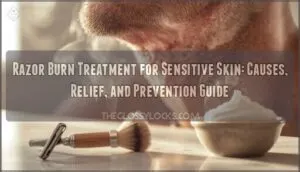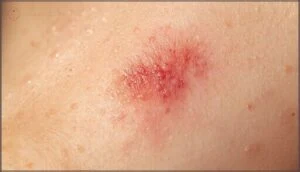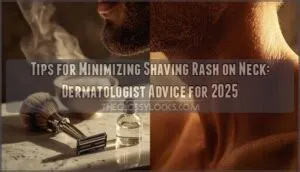This site is supported by our readers. We may earn a commission, at no cost to you, if you purchase through links.
You’d think a clean shave would feel smooth—so why does your skin fire back with burning, red blotches? Sensitive skin has a knack for turning a simple routine into an uncomfortable mess, especially when the wrong razor or a rushed hand gets involved.
Every pass over dry or unprepared skin makes irritation more likely, and sometimes a single shave leaves angry streaks that seem impossible to calm. Understanding why razor burn starts is the first step toward banishing it.
There are smarter ways to care for your face—ways that bring real relief and lasting comfort, even for sensitive skin.
Table Of Contents
Key Takeaways
- Razor burn on sensitive skin happens when a weakened skin barrier meets common mistakes like dry shaving, dull blades, or shaving against hair growth, which triggers inflammation and leaves you with redness, stinging, and sometimes ingrown hairs.
- Quick relief comes from cool compresses and hydrocortisone cream, while ingredients like aloe vera, colloidal oatmeal, and witch hazel calm inflammation and support healing without harsh chemicals.
- Prevention requires using a single-blade razor, shaving in the direction of hair growth with short strokes, and choosing fragrance-free products that protect your skin before and after each shave.
- See a doctor if you notice pus, spreading redness, fever, or symptoms lasting more than two weeks, since these signs point to infection or a deeper skin condition that needs professional treatment.
What Causes Razor Burn on Sensitive Skin?
Razor burn shows up fast when your skin is sensitive, and the reasons run deeper than you might think. It’s not just about shaving mistakes—your skin type and hair pattern matter too.
Let’s look at the main things that set the stage for irritation.
Common Shaving Mistakes
Even careful routines go sideways if you overlook a few basic shaving mistakes. The biggest culprits behind razor burn and skin irritation?
- Dry shaving, which doubles the odds of redness and stinging
- Using dull razors, often causing more nicks than a sharp blade
- Rushing or making multiple passes, especially with excessive pressure, turns a simple shave into a recipe for irritation
Smart shaving techniques are your first defense against trouble. For sensitive skin, it’s also important to think about pre-shaving preparation.
Role of Sensitive Skin in Irritation
Sensitive skin reacts more strongly to shaving because its Barrier Function is easily disrupted, exposing deeper layers to irritation and triggering an Inflammation Cascade. This explains the higher Irritation Prevalence and Unique Risk for redness, swelling, or even Secondary Infections.
Sensitive skin is easily irritated by shaving because its weakened barrier lets deeper layers inflame, raising the risk of redness, swelling, or infections
One key factor is that harsh products irritate the skin. Once that barrier is disturbed, simple razors and everyday products can turn ordinary skin care into an uncomfortable experience.
Impact of Hair Type and Growth Direction
How your hair grows shapes your shaving experience. For instance, curly hair is more likely to double back and snag under the skin, making razor burn or razor bumps common, especially for those with sensitive skin. The way your hair grows—its texture and direction—directly ties into these problems.
- Hair Texture Impact
- Growth Direction Matters
- Ingrown Hair Risk
- Shaving Technique Adaptation
- Sensitive Skin Factors
Recognizing Razor Burn Symptoms
Razor burn doesn’t always look or feel the same for everyone. Some signs are easy to spot, while others sneak up on you after shaving.
Here’s what to watch out for next time your skin feels irritated.
Redness, Itching, and Stinging
Ever notice your skin turning red right after shaving? For people with sensitive skin, razor burn brings redness, stubborn itch, and a sharp sting—sometimes all at once. These signs mean your skin’s inflammation markers spike up, signaling irritation from shaving. Fast symptom relief matters: reducing redness keeps daily life comfortable and helps protect your quality of life in the long run.
| Symptom | What It Feels Like |
|---|---|
| Redness | Blotchy, flushed areas |
| Itching | Persistent urge to scratch |
| Stinging | Sharp, tingling pain |
| Skin Irritation | Burning sensation |
| Symptom Relief | Cooling, soothing care |
Razor Bumps and Ingrown Hairs
Under the surface, razor bumps and ingrown hairs tell a story about your skin’s struggle with shaving direction, curly hair, and genetic factors. Curled hairs trap beneath the skin, sparking inflammation and discomfort. Bumps can itch, darken, or hurt—a warning signal for scarring prevention and infection risks.
- Razor bumps look like small, angry pimples
- Curly hair increases risk
- Shaving direction matters
- Persistent irritation may cause lasting marks
When Symptoms Indicate Complications
How do you know when razor burn is more than just a nuisance? If redness turns to swelling, pus, or blisters, you’re facing clear infection indicators.
When symptoms persist past a few days, disrupt your sleep, or worsen despite treatment, these are risk factors for complications.
Severe reactions and slow healing call for timely medical intervention and professional advice—don’t wait.
Effective Treatments for Razor Burn
Razor burn can be stubborn, but the right care brings real relief. There are several ways to calm irritated skin and help it heal.
Here’s what you can reach for when razor burn shows up.
Immediate Relief Methods
A cool compress can work wonders for immediate itch relief—think of it as first aid for angry skin. For stubborn redness, a thin layer of hydrocortisone cream speeds healing.
Moisturizing strategies like fragrance-free lotion or petroleum jelly help seal in moisture and calm irritation. Avoid irritation by skipping shaving and tight clothes.
Gentle natural astringents offer additional soothing skin support.
Soothing and Anti-Inflammatory Ingredients
When your skin’s shouting for relief, reach for ingredients with proven soothing properties. Dermatologists favor these powerhouses for razor burn:
- Aloe vera and colloidal oatmeal quickly calm inflammation and hydrate.
- Licorice extract and bisabolol chamomile ease irritation and redness.
- Niacinamide and allantoin strengthen your barrier, fighting skin inflammation.
Each ingredient offers real antiinflammatory benefits for sensitive skin.
Over-the-Counter and Natural Remedies
Ever wondered why aloe vera and witch hazel top so many lists? Their antiinflammatory properties make them smart first picks for topical treatments—both OTC and natural.
Many choose fragrance-free OTC creams, but others reach for natural alternatives, like skin moisturizer with plant oils. Most find relief, but pay attention to remedy safety and ingredient benefits, especially if your skin’s sensitive.
Preventing Razor Burn in Sensitive Skin
Keeping sensitive skin comfortable starts with a few smart changes to your shaving routine. A little care before, during, and after makes all the difference.
Here’s what to keep in mind every time you reach for the razor.
Proper Shaving Techniques
Think of shaving as steering a canoe through calm water—rushing causes trouble. To protect sensitive skin from razor burn, pay attention to these key habits:
- Hydrate your skin with warm water before shaving
- Use gentle, short strokes, letting the blade glide at a 30-degree angle
- Shave in the direction of hair growth
- Reapply shaving cream for each multi-pass shaving stroke
Choosing The Right Razor and Products
Choosing the right razor type makes all the difference for sensitive skin. Pro recommendations lean toward single-blade safety razors, since lower blade count means less friction and fewer nicks.
Opt for shaving creams or shaving gel made for sensitive skin—unscented is best.
Aftershave products with soothing formulas, like aloe or witch hazel, complete your skin protection routine.
Pre- and Post-Shave Skin Care Tips
After picking the right razor, how you prep and treat your skin is just as important. Use gentle cleansing before shaving. Try pre-shave oils for smoother strokes. Stick to shaving practices that go with hair growth.
When you finish, use a post-shave soothing balm and a fragrance-free skin moisturizer. Give your skin recovery time for true protection.
When to Seek Medical Advice
Sometimes, razor burn can be more than a simple irritation. Knowing when to reach out for medical help gives you peace of mind and helps keep your skin healthy.
Here are a few signs and situations where it’s wise to check in with your doctor.
Signs of Infection or Severe Reaction
How can you tell if razor burn has become more than just a skin irritation? Watch for pus or bleeding, spreading redness, blisters or oozing sores, persistent pain that keeps you up at night, or systemic signs like fever or swollen glands.
These symptoms point to a more serious skin condition—seek medical advice or urgent care right away when they appear.
Persistent or Worsening Symptoms
If your skin irritation feels stuck in a loop, don’t take it lightly—chronic symptom duration beyond two weeks, scabbing, or repeated flare-ups often point to a deeper skin condition. You should seek medical advice if you notice:
- Persistent itching or swelling
- Repeat shaving exacerbation
- Worsening symptom complications like blistering
- Impact on your quality of life
A healthcare provider can help sort stubborn ingrown hair complications from something more serious.
Managing Chronic Razor Burn Issues
If chronic razor burn keeps circling back, focus on Recurrence Risk Factors like shaving technique and blade quality. Long-Term Impacts, such as post-inflammatory hyperpigmentation, deserve attention.
Evidence-Based Strategies—like hydrocortisone cream and daily emollients—speed up skin healing and prevent skin inflammation.
For severe symptoms or potential skin conditions, schedule a Medical Consultation so irritation doesn’t turn into lasting skin damage.
Frequently Asked Questions (FAQs)
Can clothing choices affect razor burn recovery?
Loose, breathable fabrics like cotton underwear make a real difference after shaving. Tight clothing and synthetics trap moisture and create friction irritation, slowing skin healing.
Proper hygiene and fabric breathability reduce inflammation, razor burn, and other skin irritation risks.
How does stress influence razor burn flare-ups?
Like a thunderstorm brewing over a fragile field, stress raises cortisol, which weakens the skin barrier.
This invites razor burn, heightens inflammation, and makes sensitive skin more reactive—even routine shaving habits can trigger major flare-up trends.
Are certain climates harsher on newly shaved skin?
Absolutely—newly shaved skin is more vulnerable to UV exposure, humidity effects, and cold weather.
Each climate brings its own set of bacterial risks and shifting moisture needs, often causing more shaving irritation, razor burn, or dryness.
What foods worsen or help razor burn healing?
Inflammatory foods—like sugary snacks, processed meats, and dairy—can slow wound healing and drive irritation.
In contrast, healing nutrients from omega-3s, antioxidants, and staying hydrated support skin cell repair and boost antiinflammatory properties for better skin health.
Conclusion
Treating your face with care isn’t just about looking good—it’s learning to quiet the silent protest your skin makes after every shave. Sensitive skin’s whispers can turn into shouts if razor burn treatment is ignored.
Give your skin the patience and respect you’d offer an old friend. Small adjustments—smoother strokes, better products—can mean the difference between daily dread and a comfortable routine.
Listen to your skin’s language, and you’ll change the story it tells after every shave.










